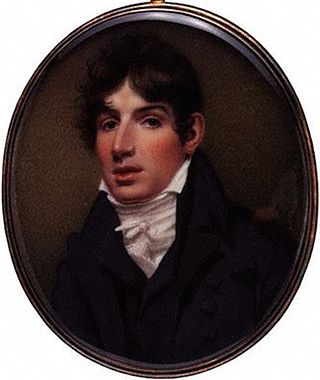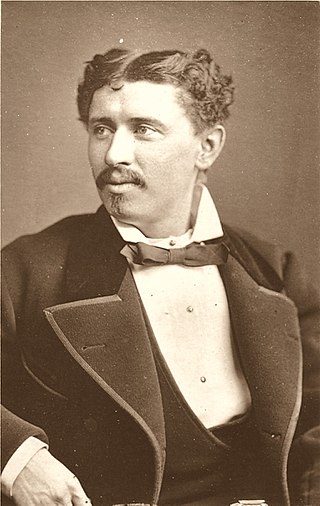Related Research Articles

Robert William Elliston was an English actor and theatre manager.

Joseph Grimaldi was an English actor, comedian and dancer, who became the most popular English entertainer of the Regency era. In the early 1800s, he expanded the role of Clown in the harlequinade that formed part of British pantomimes, notably at the Theatre Royal, Drury Lane and the Sadler's Wells and Covent Garden theatres. He became so dominant on the London comic stage that the harlequinade role of Clown became known as "Joey", and both the nickname and Grimaldi's whiteface make-up design were, and still are, used by other types of clowns. Grimaldi originated catchphrases such as "Here we are again!", which continue to feature in modern pantomimes.

The Surrey Theatre, London began life in 1782 as the Royal Circus and Equestrian Philharmonic Academy, one of the many circuses that provided entertainment of both horsemanship and drama (hippodrama). It stood in Blackfriars Road, near the junction with Westminster Bridge Road, just south of the River Thames in what is now the London Borough of Southwark.
Robert William Honner was an English actor and theatre manager.
General Sir Lionel Smith, 1st Baronet was a British diplomat, colonial administrator, and soldier.

Edward Litt Leman Blanchard, often referred to as E. L. Blanchard, was an English writer who is best known for his contributions to the Drury Lane pantomime. He began writing plays and other literature to support himself as a teenager after his father died. A succession of pantomimes supplied by him to one or other of the minor theatres, under the nom de plume of Francisco Frost, soon acquired for him a reputation as the contriver of these dramatic whimsicalities. He soon became a prolific creator of dramas and eventually gained critical acclaim for his works. He also served as a newspaper drama critic and mentored other writers.

Richardson's Theatre or Richardson's Show was a travelling fairground theatre founded in 1798 by John Richardson (1766–1836), which performed in London and the surrounding area in the early nineteenth century.
George Macfarren (1788–1843) was a playwright and the father of composer George Alexander Macfarren.
William Mower Akhurst was an actor, journalist and playwright in Australia.

Henry Siddons was an English actor and theatrical manager, now remembered as a writer on gesture.

William Oxberry (1784–1824) was an English actor. He also wrote extensively on the theatre, and was a printer and publisher.

John Thomas Haines (c.1799–1843) was a British actor and dramatist.
William Roxby Beverly or Beverley (c.1810–1889) was an English theatrical scene painter, known also as an artist in oils and watercolour. William John Lawrence, writing in the Dictionary of National Biography, considered him second only to Clarkson Stanfield among British scene painters of the 19th century.
James Sanderson was an English musician, now remembered as a composer. The tune for "Hail to the Chief", the presidential anthem of the United States, is attributed to him, taken from a Scottish Gaelic melody.

William Henry Schofield Payne was an actor, dancer and pantomimist, who created much of the stage business connected with the character Harlequin in 19th-century harlequinades. He was the father of the Victorian era pantomime clowns the Payne Brothers.

Frederick Mortimer Vokes was a British music hall, pantomime and burlesque dancer and actor of the 19th-century and a member of the Vokes Family troupe of entertainers. For more than ten years they were the central attraction at the annual pantomime at the Theatre Royal, Drury Lane from 1868 to 1879 when their popularity began to wane. Because of his eccentric style of dancing he was billed as the "Legmania" dancer.

Samuel Thomas Russell was an English actor and stage manager. He appeared many times at Drury Lane and at the Haymarket. His most famous role was Jerry Sneak in The Mayor of Garratt.

John Michael Vandenhoff was an English actor. He performed in London theatres, and also in Edinburgh and Liverpool; he played leading roles including those in Shakespearean tragedy.

Charles Marshall RA (1806–1890) was an English scene-painter.

Richard John Smith was a British actor of the early Victorian era. He was among the first to play Frankenstein's monster on stage, which he did in 1826 in The Man and The Monster; or The Fate of Frankenstein.
References
- 1 2 3 4 5 6 Knight, John Joseph (1892). . In Lee, Sidney (ed.). Dictionary of National Biography . Vol. 32. London: Smith, Elder & Co. p. 371.
- 1 2 3 4 "Lee, (Richard) Nelson". Oxford Dictionary of National Biography (online ed.). Oxford University Press. 3 January 2008. doi:10.1093/ref:odnb/16304.(Subscription or UK public library membership required.)
Attribution
 This article incorporates text from a publication now in the public domain : Knight, John Joseph (1892). "Lee, Richard Nelson". In Lee, Sidney (ed.). Dictionary of National Biography . Vol. 32. London: Smith, Elder & Co. p. 371.
This article incorporates text from a publication now in the public domain : Knight, John Joseph (1892). "Lee, Richard Nelson". In Lee, Sidney (ed.). Dictionary of National Biography . Vol. 32. London: Smith, Elder & Co. p. 371.